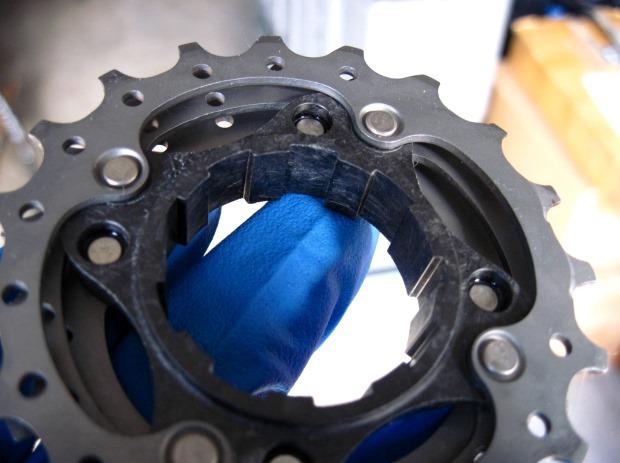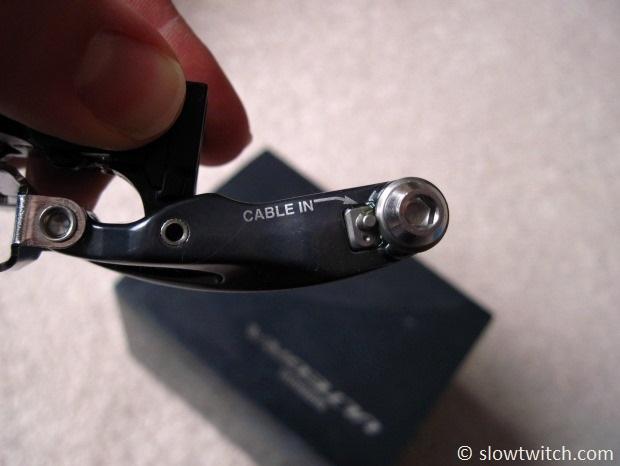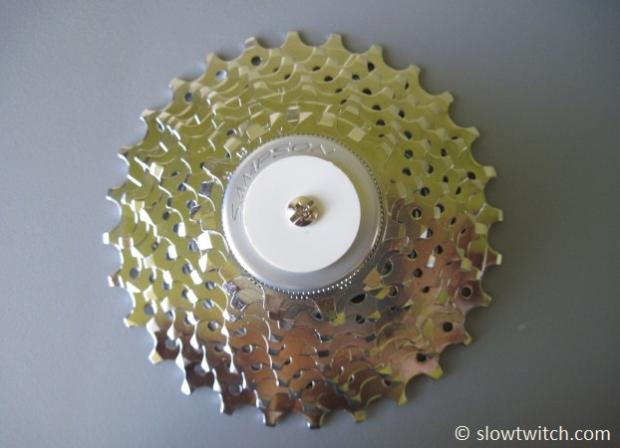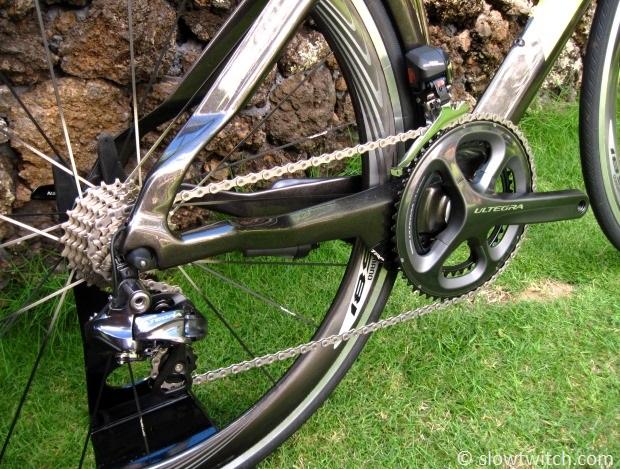Shimano debuts new 105
Shimano has been bringing out new products like hot cakes, with 11-speed Ultegra 6800 mechanical, 6870 Di2, and all of the bits that go along with these new systems – pedals, wheels, and so on. I have both Dura Ace 9000 and Ultegra 6800 systems on personal bikes, and I can attest that they bring mechanical shifting to new heights on triathlon bikes. In a sport where most athletes don’t want to think about shifting, Shimano does it as-good or better than anyone else.
Do 11-speed systems really make a difference? Inherently, no. They don’t give you free watts or improve your pedal stroke. They don’t give you an extra hour of sleep, buy you a free dinner, or even require any less maintenance than 10-speed systems.
What’s the big deal, then? The big deal, my friend, is in the potential for awesome cassette sizes. We’ve written about that in a lot of detail HERE, and suggest you check it out. In short: 11-28 is the new 11-25, and 11-32 is the new 11-28. You can have wide gearing AND reasonable ‘jumps’ between gears. Yes, you can eat your cake, too.
It’s for that very reason that we pay attention when Shimano brings 11-speed down to their third-tier level of road components, called 105 (specifically, the new generation is dubbed ‘5800’). This cool technology is now hitting a mainstream price point.
Component details
While the beauty of 11-speed lies in the cassette, the bike-geek lust lies in Shimano’s cranksets. They’ve done styling very right on the newest stuff, with a four-by-110mm bolt circle diameter:
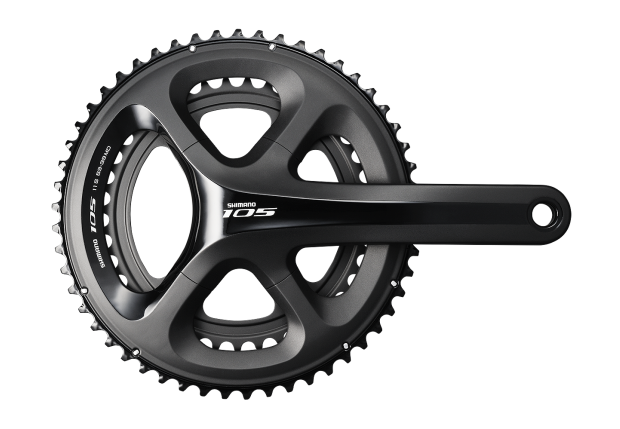
Like the entire 5800 groupset, you can have silver or black. Ring choices include 53/39, 52/36, and 50/34. We do not have details on length options yet.
Historically, I’m not a fan of proprietary bolt circle patterns. It always used to be 5 x 130 or 5 x 110 (and Campy's 135mm). Now we have hidden bolts, four arms, this, that, and the other. The only saving grace for Shimano is that their new cranks and chainrings work really well. Shifting is outstanding, accurate, and just works. I have not used the latest 105 system yet, but if it follows previous Shimano components, it will be ‘bout the same as Ultegra, but not quite up to the oh-so-perfect Dura Ace. For those running 10-speed systems and wanting to upgrade to a new crank, I have heard on several occasions that these 11-speed cranks do work just fine with a 10-speed chain and front derailleur (don’t quote me on that).
Interestingly, and perhaps sadly, it appears that Shimano is slowly but surely killing their triple chainring cranks. In a move largely started by SRAM, the industry is going to two chainrings for road bikes and not looking back. I’m personally bummed to see Shimano take this route, but I have to imagine it was at least half caused by declining sales. Dura Ace triples died with the 7900 series, Ultegra triples kicked the bucket with 6800, and 105 has finally called it quits with 5800. 11-32 cassettes help to mitigate our problem, but still do not match the overall gear range of triple systems.
Up next – shifters. Similar to other Shimano component groups, you can have a unique group-specific drop bar shifter, but not a unique bar-end shifter. They only make one level of bar-end, always called, ‘Dura Ace’. The road shifters are 105-specific, and can be seen here:
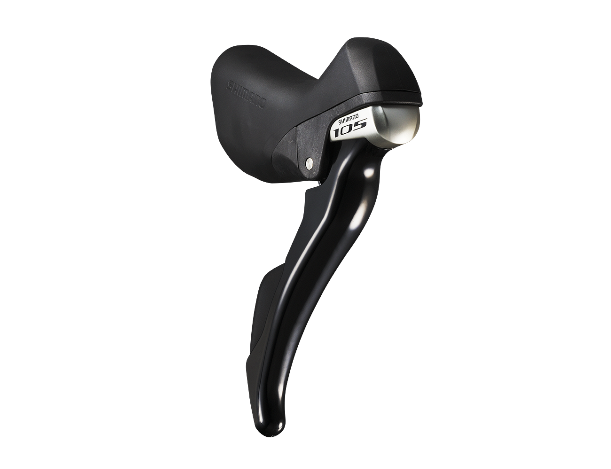
Per usual, we’re told that the new shifters offer better lever action, improved ergonomics, and shift like greased lightning covered in baby oil.
Those shifters actuate brand-new front and rear derailleurs. The front borrows design cues from Ultegra 6800, with a super-long arm:
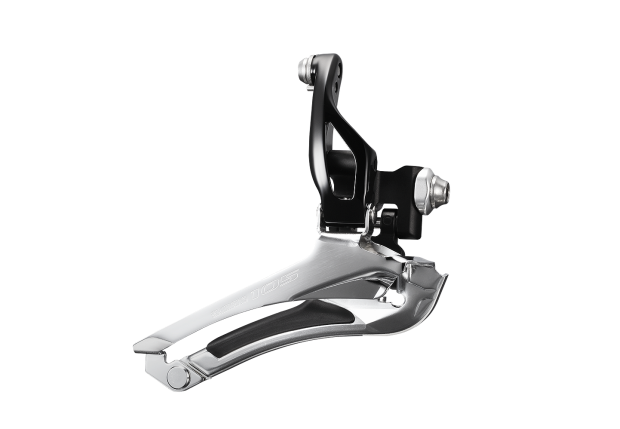
These new front derailleurs work wonderfully, even with off-brand chainrings. There’s nothing groundbreaking to say about them other than they work.
Rear derailleurs are equally no-nonsense, and offered in two cage lengths. First, we have the standard SS short cage, which accommodates cassettes up to 11-28 cassettes:
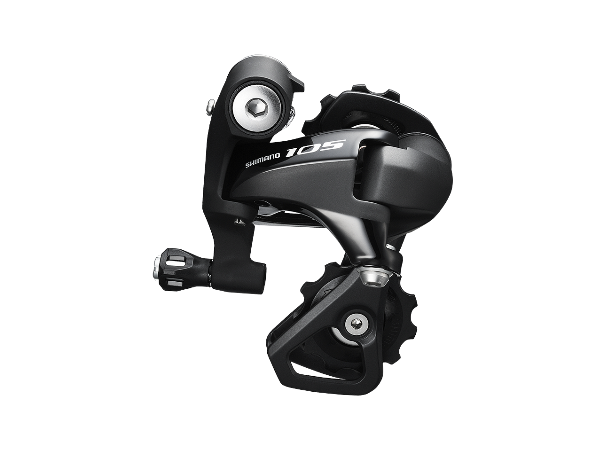
The long GS cage can handle up-to 11-32:
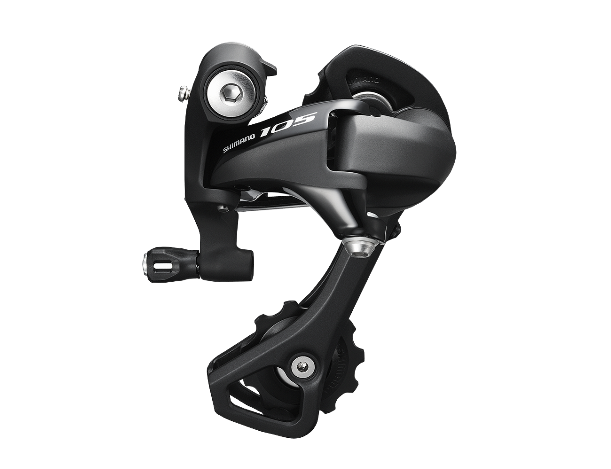
Which rear derailleur is right for you? In the past, this was a tougher decision. Mid-cage derailleurs work best with 11-28 and 11-32 cassettes, while shorties work best with 11-28 or below. Many opt for the short cage… but what if there’s that one looming race on your calendar with a SUPER steep hill? Do you buy the mid cage just for that race? Your day-to-day cassette preference may only be an 11-25.
With 11-speed, the mid-cage GS really is the better choice for the majority of the market. The reason is simple: the 11-28 size is no longer a bear around town. The jumps between gears are reasonable. It is literally a 10-speed 11-25 plus a 28. With the GS derailleur, you can still opt for a big 11-32 as-needed for your killer race. Certain riders that are A) strong, B) ride at a low cadence, or C) only ride in flat areas will be just fine with the short cage.
While we’re on the topic of cassettes, here is the new one:
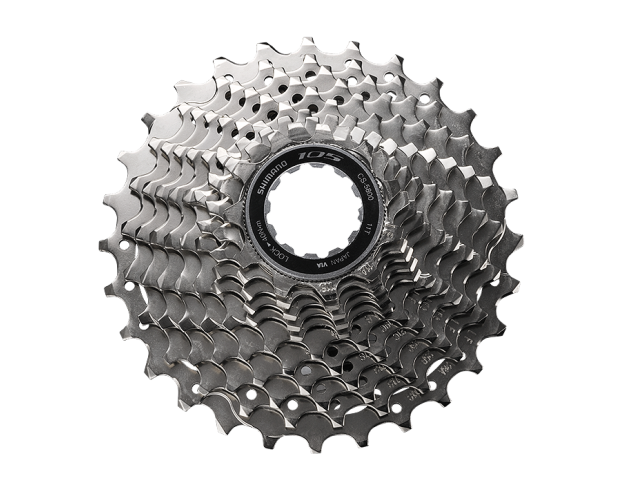
The cassette offerings in new 105 are one of the only areas of surprise. While Ultegra 6800 is offered in 11-23, 11-25, 11-28, and 11-32, the new 105 can only be had in 12-25, 11-28, and 11-32. The latter two options make perfect sense, but the 12-25 is – to me – an odd man out. With 11 gears, why not use an 11-tooth small cog? I always buy 105-level cassettes to train on, but will be out of luck on my usual 11-25 size.
The chain that wraps around our new cassette is called HG600. Shimano has waffled with symmetric and asymmetric chain designs; this one is back to asymmetric:
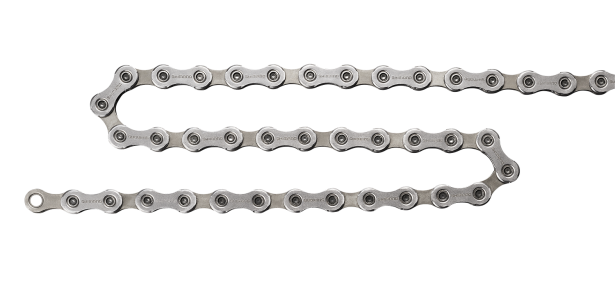
The biggest news for 105, if you ask me, is the brake system. I’m a huge fan of Shimano road brakes – especially the latest Ultegra and Dura Ace models. They’re rock-solid, smooth, and modulate about as well as you could ask of a cable-actuated brake. The new 105 brakes follow the same updated design:
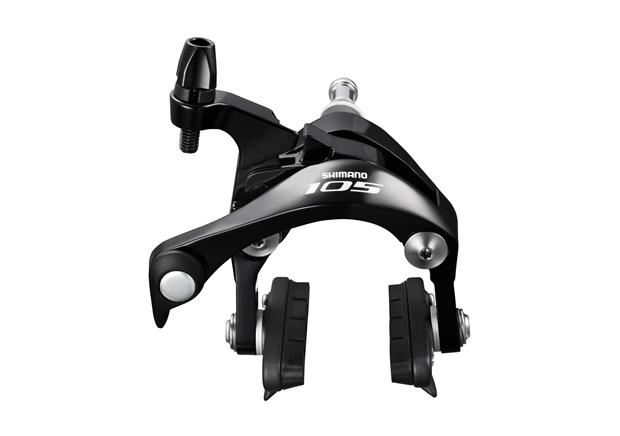
Shimano advertises that this brake can handle 28mm tires.
More than that, triathletes can say, ‘hip-hip-hooray’ for a brand new direct mount aero version of these brakes. The photo below shows the front brake:
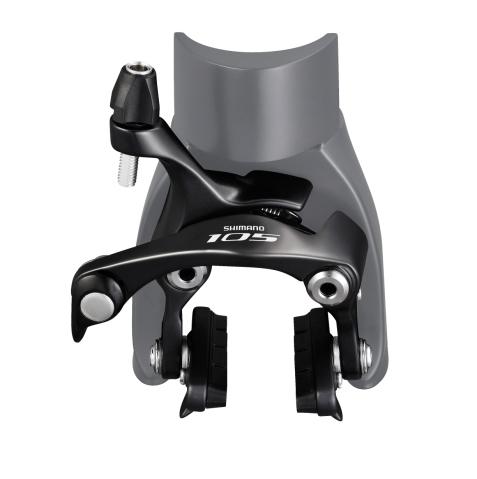
…and this photo shows the unique rear brake design under a mock bottom bracket shell:
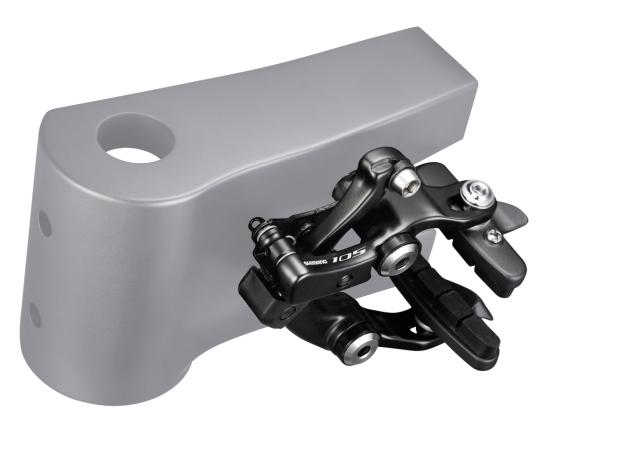
Shimano brought out a direct-mount Dura Ace 9010 brake, and I was not expecting to see this trickle down to a lower level. Now that it has, a world of possibility has opened up with spec’cing really nice brakes on bikes that don’t cost a fortune. Bad brakes have been an Achille’s heel of tri bikes for the past five or ten years, and I think that bike shops and customers have had enough. Mechanics all around the world are – right now – doing a little happy dance.
Rounding out this 105 package is a new PD-5800 carbon pedal. It features wide bearing placement and a stainless steel body cover. While it’s cool to see a carbon pedal down at 105 level, I am saddened to see that we’re losing standard pedal wrench flats. While it isn’t the end of the world, I always appreciate the mechanical friendliness of pedals that offered attachment via allen keys AND a standard wrench. Now you’re stuck with the allen wrench.
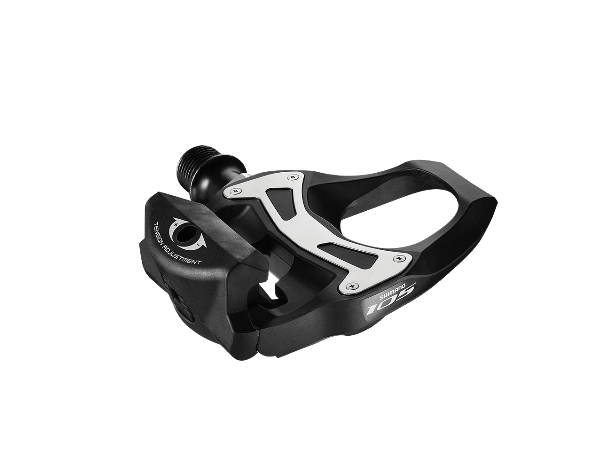
We don’t yet have an official for-sale date for the new 105, but I’m going to take the liberty of calling it a model-year 2015 product. As we know, model years don’t really mean anything anymore, with new stuff coming out all the time. The take home for these components is that I’ll expect them to start arriving on tri bikes next winter, for the 2015 racing season.
Shimano 105-5800 pricing schedule:
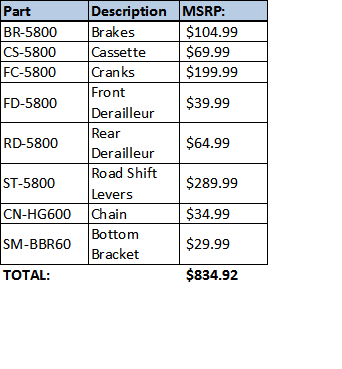
All images © Shimano



